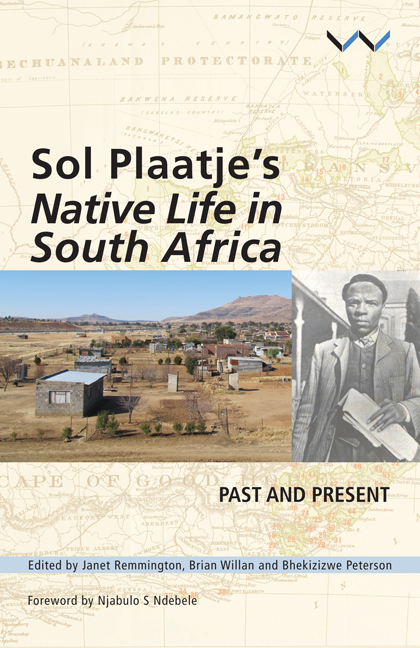Book contents
- Frontmatter
- Table of Contents
- Acknowledgements
- Foreword: Sol T Plaatje and the ‘power of all’
- Introduction: Native Life in South Africa – then and now
- Editions of Native Life in South Africa: 1916 to the present
- Looking Back: Foreword to Ravan Press edition of Native Life in South Africa, 1982
- Poetic Tributes
- What is in a name? In memory of Sol T Plaatje
- Segopoco Sa Moshui Sol T Plaatje
- In memory of the late Sol T Plaatje
- Lefatshe, nkometse
- Earth, swallow me
- Miscellaneous Frontmatter
- Chapter 1 Native Life in South Africa: Writing, publication, reception
- Chapter 2 Modernist at large: The aesthetics of Native Life in South Africa
- Chapter 3 The print world of the press and Native Life in South Africa
- Chapter 4 Going places: Native Life in South Africa and the politics of mobility
- Chapter 5 Native Life in South Africa and the world at war
- Chapter 6 African intellectual history, black cosmopolitanism and Native Life in South Africa
- Chapter 7 ‘Native Lives’ behind Native Life: Intellectual and political influences on the ANC and democratic South Africa
- Chapter 8 Whose past? Native Life in South Africa and historical writing
- Chapter 9 Women and society in Native Life in South Africa: Roles and ruptures
- Chapter 10 African progressivism, land and law: Re-reading Native Life in South Africa
- Chapter 11 Land and belonging: On the tomb ya ga Solomon Plaatje
- Chapter 12 Revisiting the landscapes of Native Life
- A Contemporary Reimagining: The Road to Dikhudung
- Contributors
- Plaatje Resources
- List of Figures
- Index
Chapter 12 - Revisiting the landscapes of Native Life
from Poetic Tributes
Published online by Cambridge University Press: 21 April 2018
- Frontmatter
- Table of Contents
- Acknowledgements
- Foreword: Sol T Plaatje and the ‘power of all’
- Introduction: Native Life in South Africa – then and now
- Editions of Native Life in South Africa: 1916 to the present
- Looking Back: Foreword to Ravan Press edition of Native Life in South Africa, 1982
- Poetic Tributes
- What is in a name? In memory of Sol T Plaatje
- Segopoco Sa Moshui Sol T Plaatje
- In memory of the late Sol T Plaatje
- Lefatshe, nkometse
- Earth, swallow me
- Miscellaneous Frontmatter
- Chapter 1 Native Life in South Africa: Writing, publication, reception
- Chapter 2 Modernist at large: The aesthetics of Native Life in South Africa
- Chapter 3 The print world of the press and Native Life in South Africa
- Chapter 4 Going places: Native Life in South Africa and the politics of mobility
- Chapter 5 Native Life in South Africa and the world at war
- Chapter 6 African intellectual history, black cosmopolitanism and Native Life in South Africa
- Chapter 7 ‘Native Lives’ behind Native Life: Intellectual and political influences on the ANC and democratic South Africa
- Chapter 8 Whose past? Native Life in South Africa and historical writing
- Chapter 9 Women and society in Native Life in South Africa: Roles and ruptures
- Chapter 10 African progressivism, land and law: Re-reading Native Life in South Africa
- Chapter 11 Land and belonging: On the tomb ya ga Solomon Plaatje
- Chapter 12 Revisiting the landscapes of Native Life
- A Contemporary Reimagining: The Road to Dikhudung
- Contributors
- Plaatje Resources
- List of Figures
- Index
Summary
One of Sol Plaatje's earliest responses to the passing of the Natives’ Land Act, a foundational piece of segregationist legislation that would define politics in unionist South Africa, was to visit Bloemhof, a village 170 km north-east of his home in Kimberley.
Setting off early one morning in the first week of July 1913, Plaatje, accompanied by an unnamed group of friends, arrived by train in this small agricultural and mining settlement on the northern banks of the Vaal River. The purpose of his visit was existential as much as journalistic. A month earlier, white parliamentarians in Cape Town had voted in favour of passing the Natives’ Land Bill. Shortly before the Bill's adoption, Plaatje had written that, if passed, the new law would deprive black inhabitants of what little they possessed and ‘make them roving wanderers and potential criminals’. Its subsequent passage into law motivated Plaatje to embark on ‘a tour of observation’ regarding the new law's early operation in the Orange Free State.
Native Life in South Africa, Plaatje's petitionary dissertation on the Natives’ Land Act, threads together first-hand observations made during a series of investigative journeys to far-flung parts of the Orange Free State and eastern parts of the Cape Colony. These descriptions are in many ways the fulcrum of Native Life: they humanise Plaatje's grand-scale political history, lending it a human-scale dimension, often in stark terms. Many of the most compelling reports were recorded in and around Bloemhof.
Beginnings matter. Arriving in Bloemhof in June 2015, intent on revisiting the places visited by Plaatje during his investigative sorties, I found myself wondering: why Bloemhof? It is an unremarkable place to start a journey. A town of 27 000 inhabitants, Bloemhof has no defining prospect. Like many of the rural towns and settlements Plaatje visited in 1913, Prince Street, Bloemhof 's main boulevard, is a muddle of formalised businesses and informal street hustle. Franchised food retailers and fuel stations, most of them owned by white businessmen, neighbour on cut-price retail stores established by recent migrants from Asia. Large diesel trucks are a constant feature of the town's life. Bound for markets in Kimberley, Klerksdorp and Johannesburg, at night they audibly disturb the quiet of Bloemhof 's idiosyncratically named guest lodges (Why Not, Villa de Rosa, Place of the Fish Eagle).
- Type
- Chapter
- Information
- Sol Plaatje's Native Life in South AfricaPast and Present, pp. 211 - 232Publisher: Wits University PressPrint publication year: 2016



